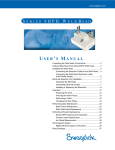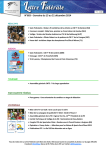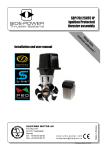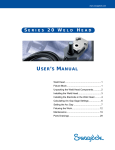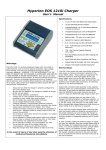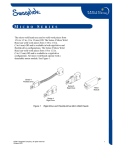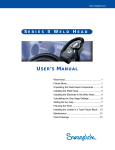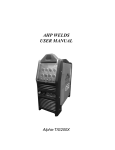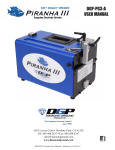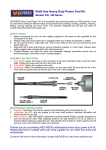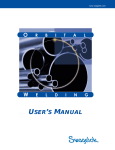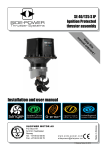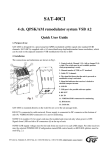Download Swagelok Welding System User Manual: Series 40 Weld Head
Transcript
E ME SWEERL DI IENSG S4 Y0S T W C L D H E A D Swagelok series 40 welding system components deliver consistent, precise welds for outside diameters from 1 1/2 to 4 in. (38,1 to 101,6 mm). A dc motor in the weld head drives a rotor, which revolves the tungsten electrode around the weld joint. Optical circuitry in the weld head sends precise feedback to the power supply to control the speed of the rotor. All moving parts in the weld head are mounted in low-friction devices to provide smooth, consistent operation. A spring-loaded, floating brush maintains contact with approximately two-thirds of the circumference of the rotor. This configuration ensures consistent, uniform electrical conductance to the rotor and electrode. ©2000 Swagelok Company, all rights reserved December 2000 Figure 1 Series 40 Weld Head 1 Series 40 Weld Head Unpacking the Weld Head Components The weld head assembly and tool package are packaged in a foam-lined shipping container. Perform the following steps when your Swagelok series 40 weld head arrives. 1. Inspect the container for damage. 2. Remove the components from the container. 3. Check the items for any damage. 4. Verify that the weld head serial number matches the serial number on the shipping container. 5. Record the model and serial numbers, and the delivery dates on page 7 of the Regulatory Module. 2 ©2000 Swagelok Company, all rights reserved December 2000 Series 40 Weld Head Installing the Weld Head Electrode Fixture Work The weld head assembly has four connectors that plug into the power supply. See Figure 2. Weld Head Shielding Gas The four connectors on the cable are: • fixture • electrode (red) • work (green) • weld head shielding gas. Figure 2 Weld Head Assembly Connect the four connectors to the rear panel of the power supply by performing the following steps (see Figure 3): 1. Locate the weld head assembly. 2. Align the notch on the multi-pin connector with the small tab in the mating socket on the rear panel labeled FIXTURE. Insert the connector in the socket. Turn the connector sleeve clockwise by hand until it is tight. This connection provides the control signals to drive the weld head. 3. Insert and fully seat the red connector into the socket on the rear panel labeled ELECTRODE. Twist the connector 1/4-turn clockwise to lock it into place. This connection is the negative (-) terminal of the weld head. 4. Insert the green connector into the socket on the rear panel labeled WORK. Twist the connector 1/4-turn clockwise to lock it into place. This connection is the positive (+) terminal of the weld head. 5. Insert the weld head shielding gas connector into the Swagelok Quick-Connect stem labeled TO WELD HEAD. Ensure that the connector is firmly attached. This connection provides shielding gas to the weld head through a solenoid valve in the power supply. ©2000 Swagelok Company, all rights reserved December 2000 Figure 3 Weld Head Connectors Caution! Ensure that the fixture connector is fully seated in the mating socket and the threaded sleeve is tight. Note: The weld head shielding gas connector must be a single-end shut-off (SESO) Swagelok Quick-Connect stem (SS-QC4-S-400). 3 Series 40 Weld Head Selecting the Electrode Electrode length depends on the desired arc gap and outside diameter of the work piece being welded. To select the correct electrode use the Calculating Tungsten Electrode Length formula. Once you have the correct length calculated either select an electrode from stock using the Electrode Selection Table or place a special order. Tungsten Electrode Length Calculation To determine the tungsten electrode length for a specific arc gap, use the formula below: (Rotor OD ÷ 2) − (Tube OD ÷ 2) − Arc Gap = Electrode Length A B Rotor OD Tube OD C Arc Gap Electrode Length Rotor OD = 6.850 in. (173,99 mm) Figure 4 Electrode Length Calculation Parameters Example No. 1: (1.5 in. to 1.5 in. tube butt weld) Rotor OD A= 6.850 in. Tube outside diameter B= 1.500 in. Desired arc gap C= 0.060 in. (6.850 ÷ 2) − (1.500 ÷ 2) − 0.060 in. = 2.615 in. Example No. 2: (38,1 mm to 38,1 mm tube butt weld) Rotor OD A = 173,99 mm Tube outside diameter B = 38,10 mm Desired arc gap C = 1,52 mm (173,99 ÷ 2) − (38,10 ÷ 2) − 1,52 mm = 66,425 mm 4 ©2000 Swagelok Company, all rights reserved December 2000 Series 40 Weld Head Table 1 Electrode Selection for 0.060 in. Arc Gap Electrode Part No. Component OD SWS-C.094-2.615-P 1.5 in. SWS-C.094-2.365-P 2.0 in. SWS-C.094-2.115-P 2.5 in. SWS-C.094-1.865-P 3.0 in. SWS-C.094-1.615-P 3.5 in. SWS-C.094-1.365-P 4.0 in. Electrode Length (L) 2.615 in. (66,40 mm) 2.365 in. (60,07 mm) 2.115 in. (53,72 mm) 1.865 in. (47,37 mm) 1.615 in (41,02 mm) 1.365 in (34,67 mm) Electrode Diameter (D) 0.094 in. (2,39 mm) 0.094 in. (2,39 mm) 0.094 in. (2,39 mm) 0.094 in. (2,39 mm) 0.094 in. (2,39 mm) 0.094 in. (2,39 mm) Note: Auto generated programs are exact lengths. You may substitute another length that is within 0.005 in. Electrode Geometry This illustration shows the electrode shape Swagelok suggests. Properly ground electrodes provide consistent, repeatable welds. Pre-ground electrodes are available from your Swagelok representative. See your parts list for ordering information. The electrode part numbers are assigned as follows: SWS – X.### - #.### - ### - P Figure 5 Electrode Diameter Material Designator C = Ceriated T = Thoriated Electrode Length Tungsten Electrode Tip Diameter Package Designator The ceriated electrode material type is a mixture of 98 % tungsten and 2 % cerium and is commonly referred to as “2 % ceriated.” This electrode type has demonstrated improved arc starting performance over the 2 % thoriated type, particularly when using purified shielding gas. ©2000 Swagelok Company, all rights reserved December 2000 5 Series 40 Weld Head Installing the Electrode 1. With the weld head in the open position, press JOG on the operator panel until the tungsten electrode is in the position shown in Figure 6. Electrode Set Screw 2. Loosen the electrode set screw. Remove the electrode if you are replacing it. 3. Insert the new electrode until it is flush with the outside edge of the rotor. 4. Tighten the electrode set screw to secure the electrode. 5. Press HOME on the operator front panel to return rotor to the home position. Electrode Outside Edge Of Rotor Figure 6 Electrode Installation Caution! Do not jog or move the rotor unless the electrode is clamped in place. 6 ©2000 Swagelok Company, all rights reserved December 2000 Series 40 Weld Head Preparing the Work It is important to prepare the tube pieces properly before welding. Refer to Figure 7. Tubing must be square and burr-free to ensure repeatable, high-quality autogenous fusion welds. Cut the tubing to length with a hacksaw or tube cutter. Face the tube ends with a lathe or a portable facing tool. Deburr the ends, making sure that both the inside and outside diameters are square and burr-free. Clean the tube ends using an appropriate solvent. Minimize the chance of a poor quality weld by following these guidelines: • Tube ends must be square. • Tube ends must not have a wall thickness variation exceeding ± 15 % of nominal. • Tube ends must be burr-free. • Tube ends must be free of any rust, grease, oil, paint, or other surface contaminates. Method Result Burrs in Flow Path Burrs Hack Saw Cut Gap End Rolled by Cutter Blade and Roller Irregular Tube Diameter Tube Cutter Burrs Face Perpendicular to Axis Reduced Flow Area Smooth Transition at Wall Faces Tube Facing Tool Square Corners No Gaps Figure 7 ©2000 Swagelok Company, all rights reserved December 2000 Tube Preparation 7 Series 40 Weld Head Operating the Weld Head Operate the weld head using the following parameters: Series 40 3 Shield gas flow rate std ft /hr (std L/min) 30 to 50① (14 to 23) Prepurge and Postpurge minimum time in seconds 45② Start Power Normal Maximum Recommended Average Amps 100 A ① Set flow to higher rates when welding at high current rates. ② Flow should be continuous for cooling when welding at high current rates. Collet Installation 1. Select the appropriate set of collets according to the tube OD of the tubing to be welded. 2. Remove the four screws holding the collets on each side of the weld head. 3. Install the selected collet. Screws (Qty. 4) 4. Reinstall the screws. Figure 8 Installing the Collet Work Piece Alignment 1. Open the window cover. 2. Open one of the fixture side plates. 3. Insert the first work piece aligning it with the tungsten electrode. 4. Close and latch the fixture side plate. 5. Open the other fixture side plate. 6. Insert the second work piece and butt the weld ends together. 7. Close and latch the fixture side plate. 8. Inspect the alignment by looking through the window cover to verify that the two work pieces are centered on the tungsten electrode. 8 Figure 9 Aligning the Work Piece with the Electrode ©2000 Swagelok Company, all rights reserved December 2000 Series 40 Weld Head Latch Tension Adjustment 1. Adjust the latch adjustment screws so that the latch is in position to exert appropriate tension on the tube. Latch Adjustment Screws Figure 10 Adjusting the Latch Tension Weld Head Mounting 1. Bolt the mounting bracket to the top of the bench. 2. Thread the power cord through the opening of the mounting bracket and seat the weld head in the position shown in Figure 11. Figure 11 Mounting the Weld Head Note: The weld head may be mounted as illustrated or turned 90°. ©2000 Swagelok Company, all rights reserved December 2000 9 Series 40 Weld Head Performing Daily Maintenance To keep your Swagelok welding system (SWS) equipment in proper working order, you must perform daily maintenance on the system components. Store the weld head in a clean, dry place. Note: If you experience problems while performing the procedures in this section, refer to Troubleshooting or contact your Swagelok representative. At the start of each workday remove dirt, carbon, and vapor deposits from the weld head rotor area with a clean, soft cloth and a solvent such as isopropyl alcohol. Rotor Area Figure 12 Inspect Exposed Surfaces of the Weld Head WARNING! DISCONNECT THE WELD HEAD FROM THE POWER SUPPLY BEFORE PERFORMING MAINTENANCE. 10 ©2000 Swagelok Company, all rights reserved December 2000 Series 40 Weld Head Performing Periodic Maintenance This section describes the procedures necessary for maintaining the weld head after every 400 to 500 welds. Parts that are found to be defective during this procedure should be replaced. For detailed part drawings and ordering information, refer to the Part Drawings beginning at the end of this manual. Spare parts are available through your Swagelok representative. Caution! Do not use lubricants inside the weld head. Weld Head Timing Check Program 1. 2. 3. 4. 5. Select PROG/CREATE. Select MANUAL ENTRY, then press ENTER. Select LEVELS ONLY, then press ENTER. Enter 2 levels, then press ENTER. Enter a programmer name. Typically it would be your name. 6. Enter the Side 1 Tube Diameter (40), then press ENTER. 7. Select 40H from the Weld Head pick list. 8. Using Table 2, enter the following parameters. Table 2 Parameters Parameter Start Power Start Current Rotor Delay Prepurge Postpurge Downslope Entry Normal 20 0 5 5 0 9. Using Table 3, enter the following parameters for level 1 and level 2. Table 3 Level 1 and Level 2 Parameters Parameter Impulse Maintenance Weld Time Ramp Pulse Rate Pulse Width Speed Hi Speed Lo Level 1 Setting 2.0 2.0 60 0 1 50 2.00 2.00 Level 2 Setting 2.0 2.0 15 0 1 50 0.00 0.00 10. Press WELD. 11. Select SAVE TO MEMORY, then press ENTER. 12. Enter the procedure name (Timing Test), then press ENTER. ©2000 Swagelok Company, all rights reserved December 2000 11 Series 40 Weld Head Weld Head Timing Test 1. Select WELD/TEST. 2. Press START. 3. After verifying the screen displays “WELD HEAD IS CLEAR TO ROTATE”, press ENTER. 4. Verify the rotor completes two revolutions then check that no part of the rotor is exposed after it stops. See Figure 13. 5. If the rotor does not complete the revolutions and stop correctly, contact your Swagelok representative. Correct Incorrect Figure 13 Rotor Position WARNING! THE ROTOR WILL ROTATE ONE REVOLUTION TO HOME POSITION 15 SECONDS AFTER COMPLETING THE TWO REVOLUTIONS 12 ©2000 Swagelok Company, all rights reserved December 2000 Series 40 Weld Head Weld Head Cleaning and Inspection This section describes how to disassemble the weld head and rotor. Weld Head To disassemble the weld head, follow these steps: 1. Blow any loose material from the weld head assembly with clean, low-pressure air. 2. Remove the four screws from the left side plate. See Figure 14. 3. Using a flat-bladed screwdriver, evenly pry the left fixture side plate off of the weld housing being careful not to damage ends of threaded alignment studs. Screws (Qty. 4) Figure 14 Removing the Left Side Plate Note: As you remove the screws from the weld head organize them so that you can reinstall them in their original holes upon reassembly. 4. Remove the long motor cover screws and the motor cover end screws. See Figure 15. Motor Cover Screws – Long (Qty. 2) Motor Cover End Screws (Qty. 2) Figure 15 Removing the Motor Cover 5. Remove the four weld head housing screws from the housing. Using a flat blade screwdriver, carefully separate the brush side from the gear side. See Figure 16. Weld Head Housing Screws (Qty. 4) 6. Carefully separate the weld head housing halves so that internal components, such as the ground pin insulators and fixture pin insulator are not damaged. See Figure 16. Figure 16 Disassembling the Weld Head Housing ©2000 Swagelok Company, all rights reserved December 2000 13 Series 40 Weld Head Brush 1. Remove the three brush screws and the two clamping plate screws. Brush Screws (Qty. 3) 2. Remove the brush from the brush side of the housing assembly. See Figure 17. 3. Inspect and clean the brush using the following steps: • Check the brush for excessive wear. Replace if necessary. • Remove any oxidation from the brush surface and brush clamp plate with a nylon abrasive pad. • Turn the brush over and remove any oxidation from the area that contacts the brush clamp plate with a nylon abrasive pad. • Remove the residue left by the abrasive pad using isopropyl alcohol and a lint-free pad. • Remove residue from the brush groove with isopropyl alcohol and a lint-free pad. 4. Reinstall the brush making sure the springs are fully seated in the brush housing. Clamping Plate Screws (Qty. 2) Figure 17 Removing the Brush Note: The brush clamp plate is attached with two Torx Plus IP-8 screws. Use a Torx Plus T8 wrench to remove. Caution! Be careful not to strip the heads or screw threads. Note: The brush should demonstrate a spring action if installed properly. 5. Screw the two short screws into the brush clamp plate. 6. Screw the three long screws into the brush housing. 14 ©2000 Swagelok Company, all rights reserved December 2000 Series 40 Weld Head Rotor 1. Inspect the gears for wear and replace if damaged by referring to the Gear Side Assembly drawing on page 22. Note: Make any necessary gear replacements before reinstalling the rotor. 2. Remove the rotor from the gear side of the housing assembly. See Figure 18. 3. Place the rotor on a clean, dry surface. 4. Inspect the rotor bearing assemblies for wear and damage. Contact your Swagelok representative if replacement is necessary. 5. If the rotor bearing assemblies are dirty, clean them with isopropyl alcohol. 6. Inspect the rotor for dirt and other deposits. Remove dirt or other deposits with a nylon abrasive pad. Figure 18 Removing the Rotor 7. Remove residue from the rotor track with isopropyl alcohol and a lint-free pad. 8. Remove the actuator tab. Inspect it for excessive wear. Replace if necessary. 9. Remove dirt or other deposits from the actuator tab with a nylon abrasive pad. 10. Remove residue left by the nylon abrasive pad from the actuator tab with isopropyl alcohol and a lint-free pad. 11. Reinstall the actuator tab. 12. Reinstall the rotor onto the rotor track making sure that it is centered. Weld Head Reassembly 1. Reinstall the brush side assembly onto the gear side assembly. 2. Replace the left side of the motor cover making sure the cable cover is seated in the stress reliever. Note: If the fixture side plate screws thread into the alignment studs and cause both to rotate without tightening, insert an Allen wrench into the alignment stud to keep it in place while you finish tightening the fixture side plate screws. 3. Replace the left side fixture plate. ©2000 Swagelok Company, all rights reserved December 2000 15 Series 40 Weld Head Home Sensor Adjustment Test the home sensor assembly for proper operation by pressing HOME on the power supply. Actuator Plate Screws If the rotor rotates continuously you will need to adjust or replace the home sensor actuator. 1. Remove the actuator cover. See Figure 19. 2. Slightly loosen the actuator plate screws. 3. Slowly rotate the home actuator switch adjustment cam clockwise until the rotor finds the home position. 4. Rotate the home actuator switch adjustment cam an additional 5°. 5. Tighten the actuator plate screws. 6. Press HOME on the power supply to verify the adjustment. 7. Reinstall the actuator cover. Figure 19 Adjusting the Home Sensor Caution! Over-adjustment of the cam will cause the home sensor to fail prematurely due to excessive pressure. Adjust the cam just past the point where the home sensor “clicks” when actuated. Actuator Replacement If adjusting the home sensor assembly does not activate the home sensor assembly, you will need to replace the actuator. 1. Remove the right fixture side plate. See Figure 20. 2. Remove and replace the home sensor actuator. 3. Repeat steps 1 to 7 of Home Sensor Adjustment. 4. Reinstall the right fixture side plate. Figure 20 Replacing the Actuator 16 ©2000 Swagelok Company, all rights reserved December 2000 Series 40 Weld Head Specifications Component Weld Head Power Cord Collets Case Parameter Max Rotor Speed E-distance Dimensions 19.2 in. Length (48,8 cm) 8.0 in. Width (20,3 cm) 2.8 in. Thickness (7,1 cm) 15 ft. (457,2 cm) 25 ft. Length (762 cm) 50 ft. (1524 cm) 2.0 in. set (5,08 cm) 3.0 in. set Tube OD (7,62 cm) 4.0 in. set (10,16 cm) 23.25 in. Length (59,1 cm) 20.75 in. Width (52,7 cm) 9.0 in. Thickness (22,86 cm) Weight 19.2 in. (48,8 cm) 12.8 lbs (5,8 kg) 4.5 lbs (2,04 kg) 7.28 lbs (3,3 kg) 14.5 lbs (6,58 kg) 7.58 lbs (3,44 kg) 6.24 lbs (2,83 kg) 4.38 lbs (1,99 kg) 8.0 in. (20,3 cm) 4.0 in. (10,16 cm) Figure 21 Specifications 13 lbs (5,9 kg) Specification 2.5 r/min Maximum 1.4 in. (35,56 mm) to the center of the electrode 1.4 in. (35,56 mm) 2.8 in. (7,1 cm) Figure 22 E-Distance ©2000 Swagelok Company, all rights reserved December 2000 17 Series 40 Weld Head 18 ©2000 Swagelok Company, all rights reserved December 2000 Series 40 Weld Head Parts Drawings This section includes exploded assembly drawings and associated parts lists. These drawings are provided as a guide to identifying part names. For specific part ordering information, contact your Swagelok representative. The parts identified in this section include: • SWS-40H Weld Head Assembly • SWS-40H Gear Side Assembly • SWS-40H Brush Side Assembly • SWS-40H Fixture Side Plate Assembly – Left • SWS-40H Fixture Side Plate Assembly – Right • SWS-40H Motor Drive Assembly ©2000 Swagelok Company, all rights reserved December 2000 19 Series 40 Weld Head 7 21 21 10 9 8 19 16 16 20 18 19 16 18 16 20 3 23 23 6 22 4 12 22 11 12 12 1 14 15 13 17 17 13 13 2 17 17 16 16 16 16 5 Figure 23 SWS-40H Weld Head 20 ©2000 Swagelok Company, all rights reserved December 2000 Series 40 Weld Head Table 4 Reference No. 1 2 3 4 5 6 7 8 9 10 11 12 13 14 15 16 17 18 SWS-40H Weld Head Parts List Description Housing (Gear Side) Assembly Housing (Brush Side) Assembly Motor Drive Assembly Fixture Side Plate Assembly Right Fixture Side Plate Assembly Left Motor Cover (Left) with Swagelok Label Motor Cover (Right) with Serial Number Label Cord Strain Relief-Left Cord Strain Relief-Middle Cord Strain Relief-Right Ground Pin Insulator Fixture Pin Insulator Fixture Pin Ground Pin Ground Pin Set Screw Fixture Side Plate Mounting Screws Housing Screws 20 Motor Drive Assembly Mounting Screw Lock Washers Motor Drive Assembly Mounting Screws Cord Strain Relief Screws 21 Motor Cover (Right) Screws- Short 22 Motor Cover (Left) Screws- Long 23 Motor Cover (Left) End Screws 19 Available in Kit No. SWS-40HP-GEARHOUSE SWS-40HP-BRSHHOUSE * SWS-40-FSP1R SWS-40FSP1L SWS-40HP-MCL SWS-40HP-MCR SWS-40HP-SR SWS-40HP-SR SWS-40HP-SR SWS-40HP-FIXPINS SWS-40HP-FIXPINS SWS-40HP-FIXPINS SWS-40HP-FIXPINS SWS-40HP-FIXPINS SWS-40HP-FIXPINS SWS-40HP-BRSHHOUSE, SWS-40HP-BRSHSCREWS * * SWS-40HP-SR SWS-40HP-MCR, SWS-40HP-MCSCREWS SWS-40HP-MCL, SWS-40HP-MCSCREWS SWS-40HP-MCL, SWS-40HP-MCSCREWS * Not available as a field replaceable spare part. ©2000 Swagelok Company, all rights reserved December 2000 21 Series 40 Weld Head 1 1 19 19 12 2 17 17 1 13 4 3 11 11 7 11 16 1 11 11 1 10 11 9 21 20 6 8 15 5 9 10 Figure 24 SWS-40H Gear Side Assembly 22 ©2000 Swagelok Company, all rights reserved December 2000 Series 40 Weld Head Table 5 Reference No. 1 2 3 4 5 6 7 8 9 10 11 12 13 14 15 16 17 18 19 20 SWS-40H Gear Side Assembly Parts List Description Housing (Gear Side) Actuator Cover Actuator Mounting Plate Actuator Switch Adjustment Cam Rotor Actuator Tab Gas Bayonet Drive Gear Assembly Primary Gear Assembly Secondary Gear Assembly Rotor Bearing Assembly Home Sensor Assembly Home Sensor Actuator Actuator Spring Actuator Tab Screw Thread Insert Actuator Plate Screws Actuator Cover Screws Home Sensor Screws 2% Ceriated Electrode 21 Electrode Set Screw * Not available as a field replaceable spare part. ©2000 Swagelok Company, all rights reserved December 2000 Available in Kit No. SWS-40HP-GEARHOUSE * * * SWS-40HP-ROTOR SWS-40HP-ACTUATOR SWS-40HP-GEARHOUSE SWS-40HP-DRGEAR SWS-40HP-PRGEAR SWS-40HP-SEGEAR SWS-40HP-GEARHOUSE * SWS-40HP-ACTUATOR SWS-40HP-ACTUATOR SWS-40HP-ACTUATOR, SWS-40HP-GEARSCREWS * SWS-40HP-GEARSCREWS SWS-40HP-GEARSCREWS SWS-40HP-GEARSCREWS SWS-C.094-2.615-P, SWS-C.094-2.365-P, SWS-C.094-2.115-P, SWS-C.094-1.865-P, SWS-C.094-1.615-P, SWS-C.094-1.365-P SWS-40HP-ESS, SWS-40HP-ROTOR 23 Series 40 Weld Head 1 5 2 6 3 6 4 7 4 4 4 7 4 4 7 Figure 25 SWS-40H Housing – Brush Side Assembly 24 ©2000 Swagelok Company, all rights reserved December 2000 Series 40 Weld Head Table 6 Reference No. 1 2 3 4 5 6 7 SWS-40H Housing – Brush Side Assembly Parts List Description Housing (Brush Side) Brush Brush Clamp Plate Brush Springs Drive Gear Plunger Brush Clamp Plate Screws Brush Screws ©2000 Swagelok Company, all rights reserved December 2000 Available in Kit No. SWS-40HP-BRSHHOUSE SWS-40HP-BRUSH SWS-40HP-BRUSH SWS-40HP-BRUSH SWS-40HP-BRSHHOUSE SWS-40HP-BRUSH, SWS-40HP-BRSHSCREWS SWS-40HP-BRUSH, SWS-40HP-BRSHSCREWS 25 Series 40 Weld Head 16 16 11 14 17 13 15 2 20 13 21 12 8 18 19 3 11 11 10 7 9 18 11 5 11 12 4 18 6 18 1 7 4 Figure 26 SWS-40H Fixture Side Plate Assembly – Left 26 ©2000 Swagelok Company, all rights reserved December 2000 Series 40 Weld Head Table 7 Reference No. 1 2 3 4 5 6 7 8 9 10 11 12 13 SWS-40H Fixture Side Plate Assembly – Left Parts List Description Bottom Fixture Plate Top Fixture Plate Latch Hook Cam Latch Arms Latch Hook Latch Lever Latch Arm Pins Latch Hook Pin Hinge Pin Latch Lever Pin Latch Lever Shims SWS-40CI-XX Collets Cover Sleeves 14 15 16 Cover Cover Spring Plunger Cover Screws 17 Wave Washer 18 19 20 21 Collet Screws Latch Hook Spring Latch Adjustment Screw Latch Adjustment Screw Washer ©2000 Swagelok Company, all rights reserved December 2000 Available in Kit No. SWS-40FSP1L SWS-40FSP1L SWS-40FSP1L, SWS-40HP-LASCREWS SWS-40FSP1L SWS-40FSP1L SWS-40FSP1L SWS-40FSP1L SWS-40FSP1L SWS-40FSP1L SWS-40FSP1L SWS-40FSP1L See Collet Ordering Information SWS-40FSP1L-CVR, SWS-40HP-CVRSCREWS SWS-40FSP1L-CVR SWS-40FSP1L SWS-40FSP1L-CVR, SWS-40HP-CVRSCREWS SWS-40FSP1L-CVR, SWS-40HP-CVRSCREWS SWS-40FSP1L, SWS-40HP-CISCREWS SWS-40FSP1L, SWS-40HP-LASCREWS SWS-40FSP1L, SWS-40HP-LASCREWS SWS-40FSP1L, SWS-40HP-LASCREWS 27 Series 40 Weld Head 2 15 16 12 13 7 14 5 13 9 3 8 11 10 11 11 11 12 4 13 13 6 8 4 1 Figure 27 SWS-40H Fixture Side Plate Assembly – Right 28 ©2000 Swagelok Company, all rights reserved December 2000 Series 40 Weld Head Table 8 Reference No. 1 2 3 4 5 6 7 8 9 10 11 12 13 14 15 16 SWS-40H Fixture Side Plate Assembly – Right Parts List Description Bottom Fixture Plate Top Fixture Plate Latch Hook Cam Latch Arms Latch Hook Latch Lever Latch Hook Pin Latch Arm Pins Hinge Pin Latch Lever Pin Latch Lever Shims SWS-40CI-XX Collets Collet Screws Latch Hook Spring Latch Adjustment Screw Latch Adjustment Screw Washer ©2000 Swagelok Company, all rights reserved December 2000 Available in Kit No. SWS-40FSP1R SWS-40FSP1R SWS-40FSP1R, SWS-40HP-LASCREWS SWS-40FSP1R SWS-40FSP1R SWS-40FSP1R SWS-40FSP1R SWS-40FSP1R SWS-40FSP1R SWS-40FSP1R SWS-40FSP1R See Collet Ordering Information SWS-40FSP1R, SWS-40HP-CISCREWS SWS-40FSP1R, SWS-40HP-LASCREWS SWS-40FSP1R, SWS-40HP-LASCREWS SWS-40FSP1R, SWS-40HP-LASCREWS 29 Series 40 Weld Head 21 21 14 22 22 13 17 22 22 2 18 12 1 26 8 20 7 25 5 9 4 6 10 24 3 24 24 24 23 23 23 23 4 15 9 16 19 11 Figure 28 SWS-40H Motor Drive Assembly 30 ©2000 Swagelok Company, all rights reserved December 2000 Series 40 Weld Head Table 9 SWS-40H Motor Drive Assembly Parts List Reference No. Description Available in Kit No. † 1 Motor Interface Mount * 2 Motor * 3 Drive Assembly Housing * 4 Drive Assembly Bearings * 5 Drive Shaft * 6 Pressure Spring Washer * 7 Drive Shaft Insulator Coupling * 8 Coupling Locking Sleeve * 9 Bearing Washer * 10 Pressure Spring * 11 Drive Pinion Gear * 12 Motor Shaft Adapter * 13 Encoder Sleeve * 14 Encoder Board Assembly * 15 Shim * 16 Shim * 17 Encoder Wheel * 18 Motor Drive Coupler Pin * 19 Pinion Coupler Pin * 20 Drive Shaft Coupler Pin * 21 Encoder Board Screws * 22 Motor Screws * 23 Motor Interface Screws * 24 Motor Interface Washers * 25 Drive Shaft Clip * 26 Coupling Sleeve Set Screw * † For part ordering information, contact your Swagelok representative. * Not available as a field replaceable spare part. ©2000 Swagelok Company, all rights reserved December 2000 31 Series 40 Weld Head 32 ©2000 Swagelok Company, all rights reserved December 2000
































